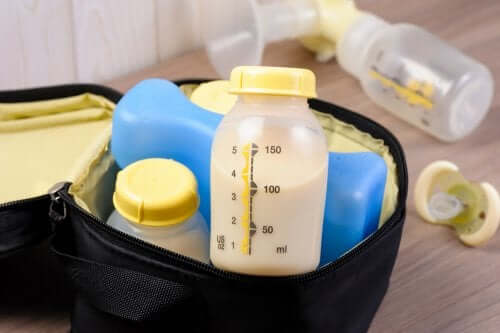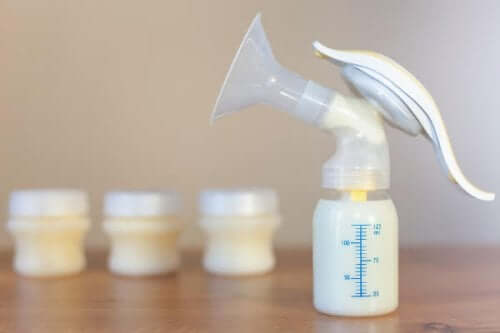Extraction and Conservation of Breast Milk
The extraction and conservation of breast milk may be necessary on many occasions, and so it's good to know the different options available.

During breastfeeding, there are situations that may require the mother to express her milk. This is why a mother needs to be well-informed about the different options available for extraction and conservation of breast milk.
The most common situations that may require pumping are the following:
- Forced separations between the mother and their newborn baby.
- Premature or hospitalized newborn baby.
- Avoiding mammary ingurgitation, mastitis, obstructions, etc.
- Donating to a breast milk bank.
- To discard the milk while the mother takes medication that would have harmful effects on the nursing infant.
- Initiating and establishing milk production in cases of re-lactation or induced lactation.
- Problems with breastfeeding or refusal to breastfeed.
Apart from these specific situations, expressing and storing breast milk is unnecessary in a normal lactation.
It’s important to always wash your hands before pumping. The release of oxytocin and the ejection of milk are improved by external stimuli such as the baby’s crying, smelling a piece of their clothing, or seeing a picture of your baby.

Extraction and conservation of breast milk
Sometimes rapid milk production is necessary. This could be the case when the newborn has lost too much weight, or when the mother wants to resume breastfeeding after a period without it. The mother may also need to do it with premature or hospitalized babies, or newborns who refuse to feed.
In these cases, the so-called power pumping technique can be used. Developed by the IBCLC Catherine Watson, it consists of hyperstimulating the breast with breast pumps, if possible two at the same time. The mother would make extractions of 10 minutes every 45-60 minutes for 24 hours, with a rest at night that doesn’t exceed 4 hours.
When the mother obtains 15-20 ml every hour, then she can carry out extractions of 20 minutes every two hours. When she obtains 40 ml every two hours, then she can perform the extractions for 30 minutes, between 6 and 8 times in 24 hours.
Experts consider that this technique isn’t working when the mother performs the extractions correctly for 48 hours and doesn’t achieve more than 100 ml per day in total.
Methods of extraction
A mother can use different methods and utensils to extract breast milk:
- Manual: To extract milk manually, you should perform a small circular massage to stimulate the breast. Then, using your thumb and fingers, form a C, first by pressing backwards and then compressing your fingers. Don’t squash or stretch the breast. This is ideal for the first few days after giving birth, as the amount of colostrum produced is small. You can collect it in a spoon or small glass and offer it to your baby.
- Mechanical extraction with breast pump:
- Manual pump: These are easy to use and give good results.
- Mini and battery powered pump: Easy to clean, good results. Suitable for long and frequent extractions.
- Large electrical pump: Easy to use, for long periods. They’re the most expensive, but can be rented. You can also apply them to both breasts at the same time if they come in a double format.
To know the size of the extractor cup that you should use, measure the nipple from end to end and add 2mm. The nipple shouldn’t rub against the inside of the cup, nor should too much of the areola enter the cup.

Preserving extracted breast milk
Here are some general recommendations to guide you, regarding the conservation of breast milk.
- Use clean containers.
- Use non-frozen milk whenever possible. Freeze unused milk as soon as possible after pumping for three days.
- Keep it in small quantities between 50 and 100 ml, in order to defrost only the one that’s going to be used.
- Label containers with the date of extraction.
- Always defrost the oldest milk. Stir it well once thawed.
- Heat water in a saucepan and, once removed from the heat, introduce the container with the extracted milk until it reaches the desired temperature, or heat it in the microwave. You shouldn’t heat it using the bain-marie method, nor directly on the cooker. Nor should you defrost it in the microwave.
Expressed breast milk can be kept at room temperature for 6-8 hours, in the refrigerator at 4°C or below for 3-5 days, and in the freezer for 2 weeks.
When you want to use breast milk that you’ve frozen, the ideal way is to thaw it in the refrigerator. It can remain there for a maximum of 24 hours. Alternatively, you can thaw it at room temperature and use it within 4 hours. Never refreeze thawed milk, and always discard any left over milk from each feeding.
It’s important to freeze the milk quickly after extraction and to heat it immediately after taking it out of the freezer. This will ensure that the milk won’t change its taste.
We hope you’ve found this information on the extraction and conservation of breast milk useful!
